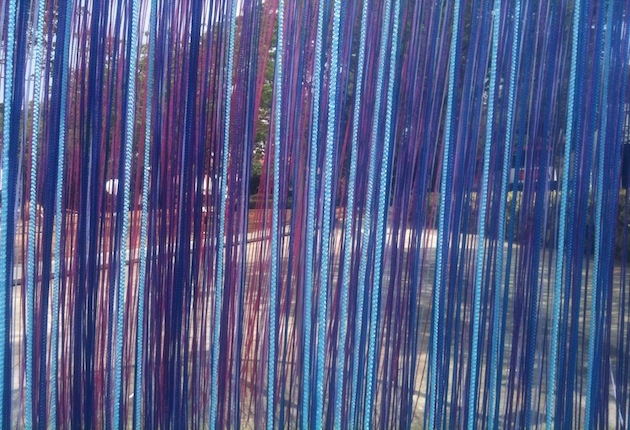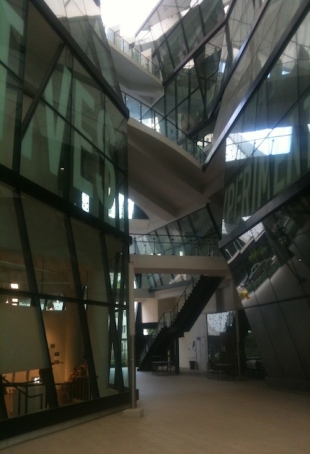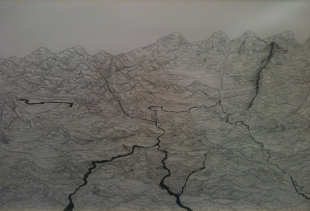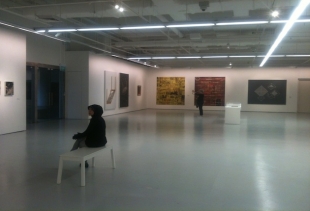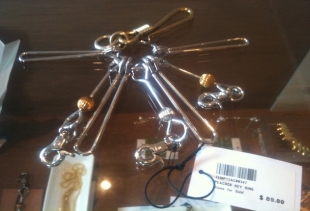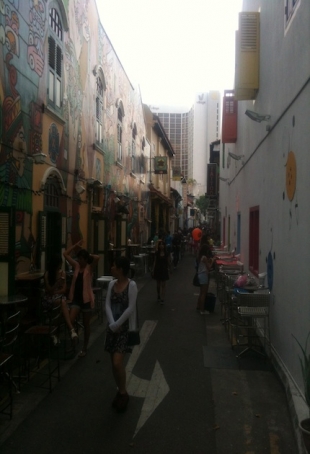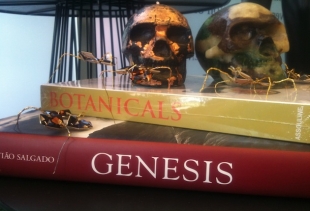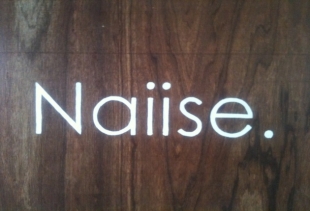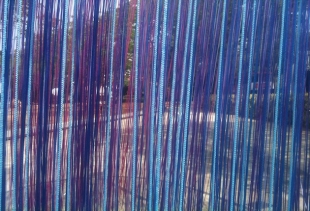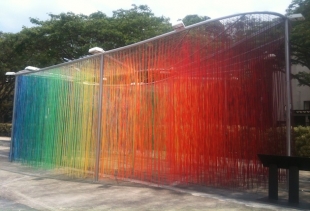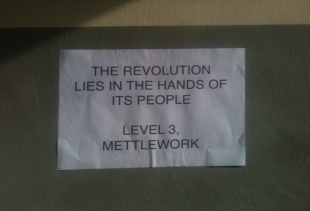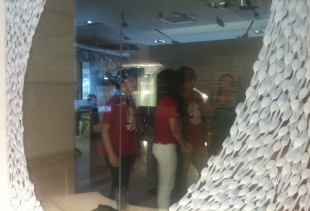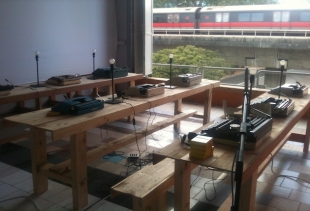» archive blog
-
Carnal, issue 0 of Parterre de Rois
A new magazine in Milandate: 18-07-2013
-
Interview with Nicola Toffolini
A worlds inventordate: 24-04-2011
-
Donne senza uomini.
Installazione multimediale di Shirin Neshatdate: 01-03-2011
Walking Singapore: a trial for design addicted
Singapore Design Week creates the new National Design Centre open all the year and free
111 Middle Road, in the middle of centrally located Art&Heritage district, hosts the brand new National Design Centre and also the main roster of appointments of Singapore Design Week that is ending today (even if many shows will last until end of March and beyond). Today is blessed by heavy rain: at the end this happened and all the inhabitants were waiting this moment since ages because water reservoirs have been threatened and all around grass and leaves have been dried up.
It is years that a design week resides here and besides the older furniture fair but only on 2014 they’ve branded themselves (yes, the Singapore Design Week – SDW - is owned by the State through its Ministry of Communication that also owns and rule the National Design Centre). Since this year, so, the SDW besides the off-site exhibits (Singaplural) signed since 3 years by the league of design companies, SFIC the same organizing IFFS, and devoted to young design, awards, educational activities, and all the other design discipline beside product and furniture (fashion, landscape, graphic and architecture): this year there are really a lot!
Let’s go on with a sort of plot. The real big news is of course the opening of National Design Centre: a strong restyling of an old female school gave birth to the design hub of the city gathering, on free entrance and all along the year, all the creative activities and clusters (also including a 3D prototyping lab, three exhibition levels of which one is front street and a bar plus a concept store). This year Singaplural has been opened also in the same building. Among master plans, architectures and fashion outfits, the Singapore Good Design Mark awarded products (SGD is a hybrid among the Red Hot and the Italian Compasso d’Oro) and other exhibits, I’ve been really touched by the last storey show devoted to alphabetize to not competitive creativity the youngsters aged only from 5 to 7: their creations have been exhibited au pair with the ones of leading designers.
Two competitions (48 Hours Design Challenge) let two teams of designers and visual merchandisers compete at Robinsons (one of the main malls of the city) and five teams coming from the main design schools of the region (among these the Nanyang and the local polytechnic) at The Park Mall (the other biggest mall, also provided with many design corners). The first two teams have been challenging themselves by using all the possible declinations of urban life (from jungle to city chic) to personalize furniture, complements, outfits and accessories that are sold in the mall together with the Swarowsky crystals (Atelier Swarosky, a new jewels collection of the famous design company, that is only from one year distributed in Asia and sold at Robinsons with a dedicated corner) sponsoring the initiative. Returning back to the competition rules, each group worked for….48 hours non stop and only using scraps (beside the design products of the involved companies). It is not an easy job, given that the first two teams were working in a small glass house outside the gigantic mall and that the seconds (all are still students, even more difficult!) were working in a very built environment and in retail shops partnering (selling from sittings, to kitchens, to textile), provided with an already strong layout. An international jury gave a price to the better team: 4800 SingDollars that went to Temasek Polytechnik for their intervention on brand Hugo Kitchen: they’ve transformed the windows of the show by building a kind of décor with more than 6000 plastic servers.
It is not an easy job to let normal audience approach the design world and SFIC this year did it also by inviting 15 visual artists and 15 designers to work on a very beloved heritage: the logs crashed for storms in the many well maintained city parks (nevertheless the dry times). In one of these just in front of The Park Mall (Dobhy Ghauth Green) there are 28 (the missing two are at National Design Centre) pieces obtained by trees and usable by the citizens. 30 Lifestories iremember parks is not only a clever re-use process but also a research on memories of young and not creative citizens that added their impressions and thoughts by generating their own piece. The same park hosts also six other big installations, among them there is Spectrum by the Swiss architect Claudio Colucci (one of the jury members with David Carlson, Timothy Power and the Japanese Yoichi Nakamuta, International Curator of Singaplural this year): Spectrum is a big cage with the walls made of crossable texture ropes and in front of it similar benches are made from young local designer Creativeans, also exhibiting in Park Mall with new works on a cardboard table (The Periodic Table) together with Desinere and artist Pang+Kanako, because all designs on shows are tableware.
The 21st edition of Furniture Design Award (all pieces on show at National Design Centre) saw two awarded (one in each of the categories: students, designers): Stool, by Agnieszka Klimowicz, from Polish-Japanese Institute of Information Technology and the piece I’ve liked best, The Link Shelf by US designer Trygve Faste. Among the shortlisted interior projects, very uncommon and playful is Poochfam, a pet-human set providing a table with a pet mat and a lamp with light remote control enabling pets to jump in a loop on the base of the stand of the lamp to switch on-off it (from an idea of a Hong Kong University student, miss Chow Ka Yi).
Every meter of National Design Centre is hosting small expos of companies and designers who merged thanks to the match-making SFIC conducts all the year. And exhibits also a very peculiar new design company born this year in Singapore, industry+, by an idea of Mr Nakamuta who is heading it (he is permanent resident since two years): the local designers’ skills are conjugated with the main and best productive ones and there is already a collection of furniture and complements, lighting included, by seven authors, as Atelier Ikebuchi, Olivia Lee, Hans Tan, OutofStock, Studio Juju, Ministry of Design, VW+BS. Tables, sits, lamps, nylon textile and mirrors are on show until March 31 at the new design centre on 111 Middle Road. Take an eye on who is and what Olivia Lee designed, among the other industry+ authors: she is more on the edge between art and design and is signing two very adventurous pieces. Revere a flower pot set in blown glass that search (and reach) the balance on the surface you put on after a while. And Float is a coffee table obtained by casting large lotus leaves in transparent resin.
For the first time this year, the governmental agency Design Singapore is testing itself by organizing also free tours (only yesterday, 11am-6pm), called Design Trials that allowed any kind of citizen to approach the jungle of creative industry from the view point of small business, informal economy and artists’ studio, passing by pop-up and concept stores and, why not, the stunning city art and design academies, as Lasalle. The departing and arrival hub has been the Design Centre and two have been the itineraries: I noted that for each of the tours, the crowd was full of families and singles who, attired by the very centrally located new building, have been excited to be put through design, this very unknown thing. I did one of my last trip in the North Loop, for instance, by talking with a nice family of four persons: the father, a musician, was followed by the wife and two sons, a young boy and a 16years old girl. She was the one hearing about the Design Trials and so involving all the rest of the family to spend a very unusual afternoon to rediscover their own city. She loves Milan, Montenapoleone and the fashion but likes to study finance and is attracted to work in arts management or fashion-finance merger operation.
The minivans non-stop shuttling venue by venue were carrying – and this has been amazing – families, youngsters, retired people, tourists and residents, design officers and press all together. We were all challenging in our own way the tropical weather and the dry atmosphere of the super-rich Singapore – whose streets are covered by packed and cold malls where never or almost never you can find a furniture or design shop. Visitors in this way meet the young generations of authors but also the not visible informal economies of the town they generate (and they are quite often located out of the Arts&Heritage District).
The most intense Trial experience to me has been indeed to visit the less central districts where I was trying to not be overwhelmed by the heat by eating a banana choco Popaganda, design stick ice-cream only made of fruit and no added sugar (this we have to import right now!). In this part of the Trial I discovered incredible design shops located in gigantic tower-blocks similar to the ones depicted in contemporary Russian or Chinese movies: entering there you’ll never expect to find the latest published local stylish magazine (as the issue one of Afterglobe, a Singapore travel Magazine, signed by young local journalists and designers that is launching a call for entries for the issue 2, called Seasons ending April 20) just beside a traditional food store non-stop grilling, at street level, ducks, bacon slices and chicken sausages.
These concept stores exhibit - with a not taken for granted touch and without imitating a false Europe Oriented style – the last local news in terms of lifestyle: from the bikes to the fashion garments and bags. The best of this latter I’ve seen at Tyrwhitt, also the best shop of the Trial (owned by a very worldy oriented S’rean girl, Netty): only made in Singapore there are unisex or every-sex market bags or 24hrs office bags mixing English tweed and local reverse-change textiles with leather inserts. You can find them only in the district of Jalan Beshar, a former 18th Century outpost for plantations owners (now considered an heritage district) where you can see Little India outskirts, old barracks and hipsters bar all living together (this latter can be placed with no mistake also in Williamsburg or in the miserable Ticinese, in Milan). Jalan Beshar will be touched by a new MRT station on 2017: it means within a century, for the fast and furious Singapore.
Not only the usual everywhere hipsters colonies with all the sampling of à-la-page haircuts and omnivore sexual appetites. Not only old districts that change skin from the night to the morning (and where in the middle of improvised food courts on the pedestrians side between two rows of low houses exactly as it happened fifty years ago, you can find also a red district that is one of the most health-controlled of the world). Thanks to the Trial I’ve visited also a tower building where, on the top of the disused spaces, I found an artists, poets and designers compound called The Mettle Work and located in Geylang (what we can call quasi outskirt in the direction north-east): the residents were welcoming the visitors while setting the sound system for the performances they would have offered during the whole evening.
While I was trying to visit the last stop of the North Loop Design Trial (Zarch Collaborative Office, an award winning architects studio located in the Golden Mile Complex, a residential area only 2 km from National Design Centre that is considered already vintage in terms of style in building skyscrapers now while just few years ago it was the new in town), I’ve been left out of the last bus: the practice closed earlier and nobody told me that the bus on which I was already on would have been the last of the day. Desperate in the middle of the peak hour for the taxis and with no interest to take the hundredth time the subway that was not allowing me to see the city texture, I decided to walk until my hotel, the Carlton, located only 3 kilometres from there.
In Italy I walk for heavier distances everyday, so I thought to make it simple. Indeed, I succeeded but only watering myself at every place people were wetting the poor and dry public plants on the street. In a way I thank the bus defaillance and the miscommunication between the volunteers at the last Trial stop because this gave me the opportunity to help me to understand more of the city in which I am. All the areas, included the central ones, are similar to what seen at Geylang and Jalan Basar: enormous vertical jungles (the skyscrapers and all those buildings branded by the corporations, from banks to offices to hotels) are spotting any single view (especially from the ground level), but here and there few enclaves of small original compounds resist and stay: they’re consisting of prayer houses and temples, two-storey shop houses often inhabited by Muslims, Malaysian or Indian, painted in bright colours and provided with a shop basement and with a flat upon it. They are more chaotic and confused in the northern areas, strongly super bobo (but less authentic) in the small pedestrian endroit you pass the more you approach the Arts&Heritage district, as Haji Lane. Entering these small bits of “anterior” landscape is like travel back in the time. Scents and proxemics included.

